Carboxymethyl Cellulose Hydrogel from Biomass Waste of Oil Palm Empty Fruit Bunch Using Calcium Chloride as Crosslinking Agent
Abstract
:1. Introduction
2. Materials and Methods
2.1. Materials
2.2. Preparation of CMC
2.3. Preparation of CMC Hydrogel
2.4. Gel Content and Degree of Swelling of CMC Hydrogel
2.5. Characterization
3. Results
3.1. Optimization of CMC Hydrogel
3.1.1. Effect of CMC Concentration on CMC Hydrogel
3.1.2. Effect of CaCl2 Concentration on CMC Hydrogel
3.1.3. Effect of Different Reaction Times on CMC Hydrogel
3.1.4. Effect of Different Reaction Temperatures on CMC Hydrogel
3.2. Characterization
3.2.1. Fourier Transform-Infrared Spectroscopy (FT-IR)
3.2.2. X-ray Diffraction (XRD)
3.2.3. Thermogravimetry Analysis (TGA)
3.2.4. Field Emission Scanning Electron Microscopy (FESEM)
4. Conclusions
Author Contributions
Funding
Institutional Review Board Statement
Informed Consent Statement
Data Availability Statement
Acknowledgments
Conflicts of Interest
References
- Yadav, H.; Karthikeyan, C. Natural polysaccharides: Structural features and properties. In Polysaccharide Carriers for Drug Delivery; Woodhead Publishing: Sawston, CA, USA, 2019; pp. 1–17. [Google Scholar] [CrossRef]
- Cheng, H.N.; Gu, Q.-M. Enzyme-Catalyzed Modifications of Polysaccharides and Poly(ethylene glycol). Polymers 2012, 4, 1311–1330. [Google Scholar] [CrossRef] [Green Version]
- Thakur, V.K.; Thakur, M.K. Processing and characterization of natural cellulose fibers/thermoset polymer composites. Carbohydr. Polym. 2014, 109, 102–117. [Google Scholar] [CrossRef]
- Klemm, D.; Heublein, B.; Fink, H.; Bohn, A. Fascinating Biopolymer and Sustainable Raw Material Angewandte. Polym. Sci. Cellul. 2005, 44, 3358–3393. [Google Scholar]
- Lindman, B.; Karlström, G.; Stigsson, L. On the Mechanism of Dissolution of Cellulose. J. Mol. Liq. 2010, 156, 76–81. [Google Scholar] [CrossRef]
- Kushairi, A.; Loh, S.K.; Azman, I.; Hishamuddin, E.; Ong-Abdullah, M.; Izuddin, Z.B.M.N.; Razmah, G.; Sundram, S.; Parveez, G.K.A. Oil Palm Economic Performance in Malaysia and R&D Progress in 2017. J. Oil Palm Res. 2018, 30, 163–195. [Google Scholar]
- Megashah, L.N.; Ariffin, H.; Zakaria, M.R.; Hassan, M.A. Multi-step pretreatment as an eco-efficient pretreatment method for the production of cellulose nanofiber from oil palm empty fruit bunch. Asia Pac. J. Mol. Biol. Biotechnol. 2018, 26, 1–8. [Google Scholar] [CrossRef]
- Hassan, M.A.; Abd-Aziz, S. Waste and Environmental Management in the Malaysian Palm Oil Industry. In Palm Oil 2012; AOCS Press: Urbana, IL, USA, 2012; pp. 693–711. [Google Scholar] [CrossRef]
- Shuit, S.H.; Tan, K.T.; Lee, K.T.; Kamaruddin, A.H. Oil palm biomass as a sustainable energy source: A Malaysian case study. Energy 2009, 34, 1225–1235. [Google Scholar] [CrossRef] [Green Version]
- Chen, G.; Tang, W.; Wang, X.; Zhao, X.; Chen, C.; Zhu, Z. Applications of Hydrogels with Special Physical Properties in Biomedicine. Polymers 2019, 11, 1420. [Google Scholar] [CrossRef] [PubMed] [Green Version]
- Buhus, G.; Popa, M.; Desbrieres, J. Hydrogels Based on Carboxymethylcellulose and Gelatin for Inclusion and Release of Chloramphenicol. J. Bioact. Compat. Polym. 2009, 24, 525–545. [Google Scholar] [CrossRef]
- Ambrosio, L.; Demitri, C.; Sannino, A. Superabsorbent Cellulose-Based Hydrogels for Biomedical Applications. In Biomedical Hydrogels; Woodhead Publishing Limited: Chicago, IL, USA, 2011; pp. 25–50. [Google Scholar] [CrossRef]
- Bhattarai, N.; Gunn, J.; Zhang, M. Chitosan-based hydrogels for controlled, localized drug delivery. Adv. Drug Deliv. Rev. 2010, 62, 83–99. [Google Scholar] [CrossRef] [PubMed]
- Fei, B.; Wach, R.; Mitomo, H.; Yoshii, F.; Kume, T. Hydrogel of biodegradable cellulose derivatives. I. Radiation-induced crosslinking of CMC. J. Appl. Polym. Sci. 2000, 78, 278–283. [Google Scholar] [CrossRef]
- Sharma, S.; Sathasivam, T.; Rawat, P.; Pushpamalar, J. Lycopene-loaded nanostructured lipid carrier from carboxymethyl oil palm empty fruit bunch cellulose for topical administration. Carbohydr. Polym. Technol. Appl. 2021, 2, 100049. [Google Scholar] [CrossRef]
- Young, S.; Wong, M.; Tabata, Y.; Mikos, A.G. Gelatin as a delivery vehicle for the controlled release of bioactive molecules. J. Control. Release 2005, 109, 256–274. [Google Scholar] [CrossRef]
- Dong, M.; Chen, Y. The stimuli-responsive properties of hydrogels based on natural polymers. In Hydrogels Based on Natural Polymers; Elsevier: Amsterdam, The Netherlands, 2019; pp. 173–222. [Google Scholar] [CrossRef]
- Baldino, L.; Zuppolini, S.; Cardea, S.; Diodato, L.; Borriello, A.; Reverchon, E.; Nicolais, L. Production of biodegradable superabsorbent aerogels using a supercritical CO2 assisted drying. J. Supercrit. Fluids 2019, 156, 104681. [Google Scholar] [CrossRef]
- Reeves, R.; Ribeiro, A.; Lombardo, L.; Boyer, R.; Leach, J.B. Synthesis and Characterization of Carboxymethylcellulose-Methacrylate Hydrogel Cell Scaffolds. Polymers 2010, 2, 252–264. [Google Scholar] [CrossRef] [PubMed] [Green Version]
- Rambo, M.K.D.; Ferreira, M.M.C. Determination of Cellulose Crystallinity of Banana Residues Using Near Infrared Spectroscopy and Multivariate Analysis. J. Braz. Chem. Soc. 2015, 26, 1491–1499. [Google Scholar] [CrossRef]
- Sultana, S.; Islam, M.R. Effect of Mono- And Divalent Salts on The Properties of Carboxymethyl Cellulose Hydrogel Under Irradiation Technique. Int. J. Chem. Sci. 2012, 10, 627–634. [Google Scholar]
- Che Nan, N.F.; Zainuddin, N.; Ahmad, M. Preparation and Swelling Study of CMC Hydrogel as Potential Superabsorbent. Pertanika J. Sci. Technol. 2019, 27, 489–498. [Google Scholar]
- Khaled, B.; Abdelbaki, B. Rheological and Electrokinetic Properties of Carboxymethylcellulose-Water Dispersions in the Presence of Salts. Int. J. Phys. Sci. 2012, 7, 1790–1798. [Google Scholar]
- Tolinski, M. Crosslinking. In Additives for Polyolefins; William Andrew Pub.: Oxford, UK, 2009; pp. 215–220. [Google Scholar]
- Maitra, J.; Shukla, V.K. Cross-linking in Hydrogels—A Review. Am. J. Polym. Sci. 2014, 4, 25–31. [Google Scholar]
- Nie, H.; Liu, M.; Zhan, F.; Guo, M. Factors on the preparation of carboxymethylcellulose hydrogel and its degradation behavior in soil. Carbohydr. Polym. 2004, 58, 185–189. [Google Scholar] [CrossRef]
- Ngadi, N.; Lani, N.S. Extraction and Characterization of Cellulose from Empty Fruit Bunch (EFB) Fiber. J. Teknol. 2014, 68. [Google Scholar] [CrossRef] [Green Version]
- Tulain, U.R.; Ahmad, M.; Rashid, A.; Iqbal, F.M. development and characterization of smart drug delivery System. Acta Pol. Pharm.-Drug Res. 2016, 73, 1009–1022. [Google Scholar]
- Sharratt, W.N.; Lopez, C.G.; Sarkis, M.; Tyagi, G.; O’Connell, R.; Rogers, S.E.; Cabral, J.T. Ionotropic Gelation Fronts in Sodium Carboxymethyl Cellulose for Hydrogel Particle Formation. Gels 2021, 7, 44. [Google Scholar] [CrossRef]
- Navarra, M.A.; Bosco, C.D.; Moreno, J.S.; Vitucci, F.M.; Paolone, A.; Panero, S. Synthesis and Characterization of Cellulose-Based Hydrogels to Be Used as Gel Electrolytes. Membranes 2015, 5, 810–823. [Google Scholar] [CrossRef] [PubMed] [Green Version]
- Zailan, D.; Hashim, S.N. Factors Affecting Cellulose Dissolution of Oil Palm Empty Fruit Bunch and Kenaf Pulp in NaOH/Urea Solvent. Sains Malays. 2018, 47, 377–386. [Google Scholar]
- Uyanga, K.A.; Daoud, W.A. Carboxymethyl cellulose-chitosan composite hydrogel: Modelling and experimental study of the effect of composition on microstructure and swelling response. Int. J. Biol. Macromol. 2021, 181, 1010–1022. [Google Scholar] [CrossRef] [PubMed]
- Casaburi, A.; Rojo, M.; Cerrutti, P.; Vázquez, A.; Foresti, M.L. Carboxymethyl cellulose with tailored degree of substitution obtained from bacterial cellulose. Food Hydrocoll. 2018, 75, 147–156. [Google Scholar] [CrossRef]
- He, X.; Wu, S.; Fu, D.; Ni, J. Preparation of sodium carboxymethyl cellulose from paper sludge. J. Chem. Technol. Biotechnol. 2008, 84, 427–434. [Google Scholar] [CrossRef]
- Mohtar, S.S.; Busu, T.N.Z.T.M.; Noor, A.M.M.; Shaari, N.; Mat, H. An ionic liquid treatment and fractionation of cellulose, hemicellulose and lignin from oil palm empty fruit bunch. Carbohydr. Polym. 2017, 166, 291–299. [Google Scholar] [CrossRef]
- Khalid, M.; Ratnam, C.T.; Luqman, C.A.; Salmiaton, A.; Choong, T.S.Y.; Jalaludin, H. Thermal and Dynamic Mechanical Behavior of Cellulose- and Oil Palm Empty Fruit Bunch (OPEFB)-Filled Polypropylene Biocomposites. Polym. Technol. Eng. 2009, 48, 1244–1251. [Google Scholar] [CrossRef]
- Akar, E.; Altınışık, A.; Seki, Y. Preparation of pH- and ionic-strength responsive biodegradable fumaric acid crosslinked carboxymethyl cellulose. Carbohydr. Polym. 2012, 90, 1634–1641. [Google Scholar] [CrossRef] [PubMed]
- Salleh, K.M.; Zakaria, S.; Sajab, M.S.; Gan, S.; Kaco, H. Superabsorbent hydrogel from oil palm empty fruit bunch cellulose and sodium carboxymethylcellulose. Int. J. Biol. Macromol. 2019, 131, 50–59. [Google Scholar] [CrossRef] [PubMed]
- Tudorachi, N.; Lipsa, R.; Mustata, F.R. Thermal Degradation of Carboxymethyl Starch-g-Poly(Lactic Acid) Copolymer by TG−FTIR−MS Analysis. Ind. Eng. Chem. Res. 2012, 51, 15537–15545. [Google Scholar] [CrossRef]
- El-Sakhawy, M.; Tohamy, H.-A.S.; Salama, A.; Kamel, S. Thermal properties of carboxymethyl cellulose acetate butyrate. Cellul. Chem. Technol. 2019, 53, 667–675. [Google Scholar] [CrossRef]
- Seki, Y.; Altinisik, A.; Demircioğlu, B.; Tetik, C. Carboxymethylcellulose (CMC)–hydroxyethylcellulose (HEC) based hydrogels: Synthesis and characterization. Cellulose 2014, 21, 1689–1698. [Google Scholar] [CrossRef]
- Parid, D.M.; Abd Rahman, N.A.; Baharuddin, A.S.; Mohammed, M.A.; Johari, A.M.; Razak, S.Z. Synthesis and Characterization of Carboxymethyl Cellulose from Oil Palm Empty Fruit Bunch Stalk Fibres. BioResources 2018, 13, 535–554. [Google Scholar]
- Sreekala, M.S.; Kumaran, M.G.; Thomas, S. Oil Palm Fibers: Morphology, Chemical Composition, Surface Modification, and Mechanical Properties. J. Appl. Polym. Sci. 1997, 66, 821–835. [Google Scholar] [CrossRef]
- Rahman, M.S.; Islam, M.M.; Islam, M.S.; Zaman, A.; Ahmed, T.; Biswas, S.; Sharmeen, S.; Rashid, T.U.; Rahman, M.M. Morphological Characterization of Hydrogels. In Cellulose-Based Superabsorbent Hydrogels; Springer International Publishing AG: New York, NY, USA, 2019; pp. 819–863. [Google Scholar]
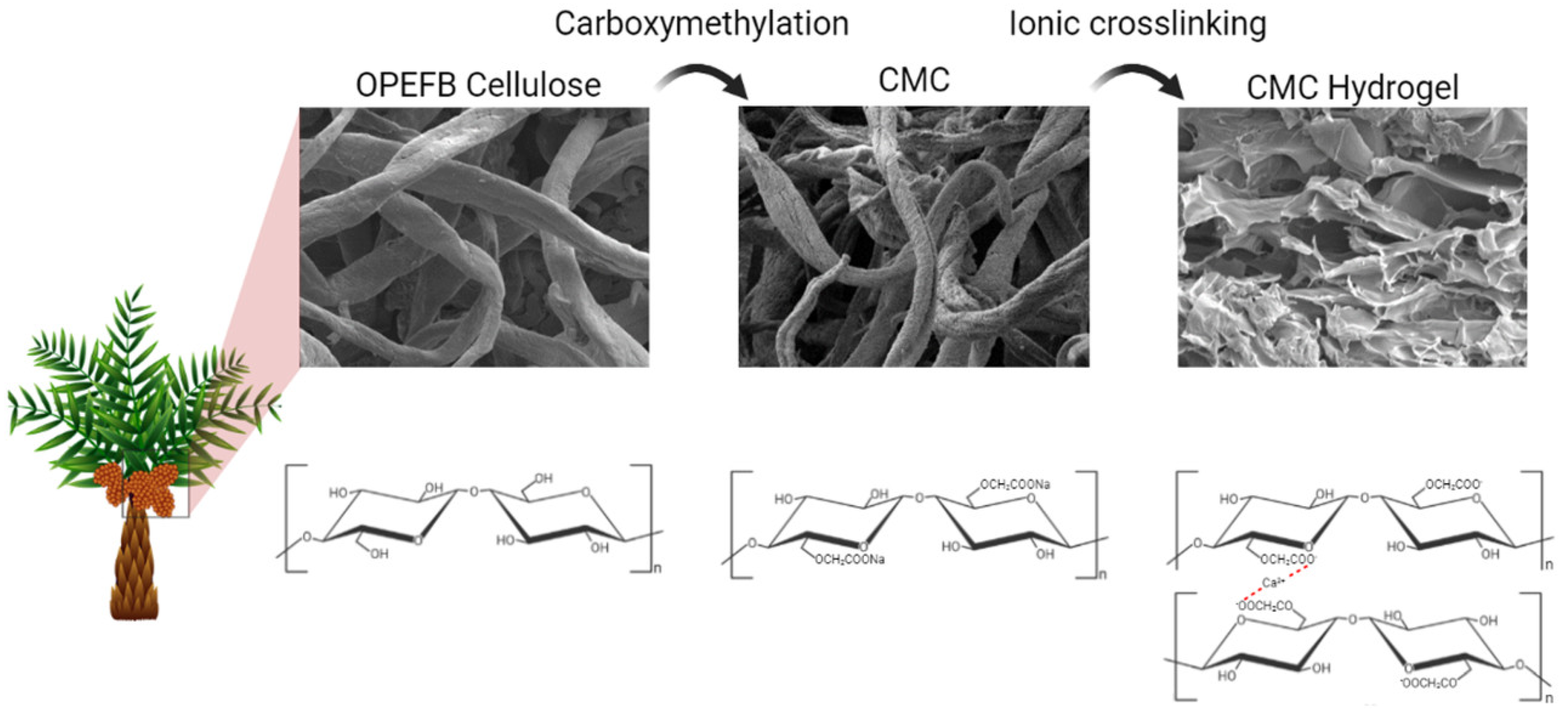
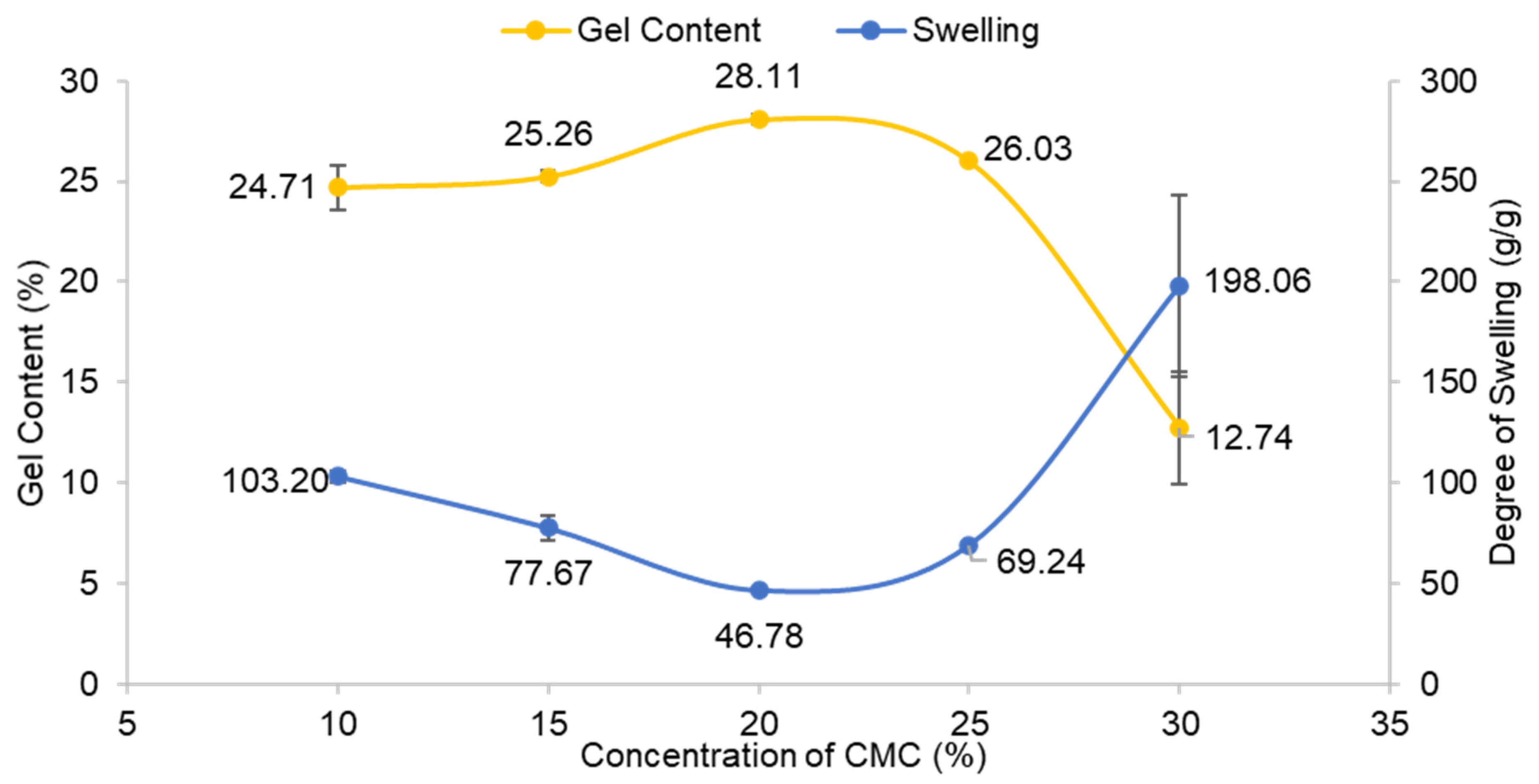
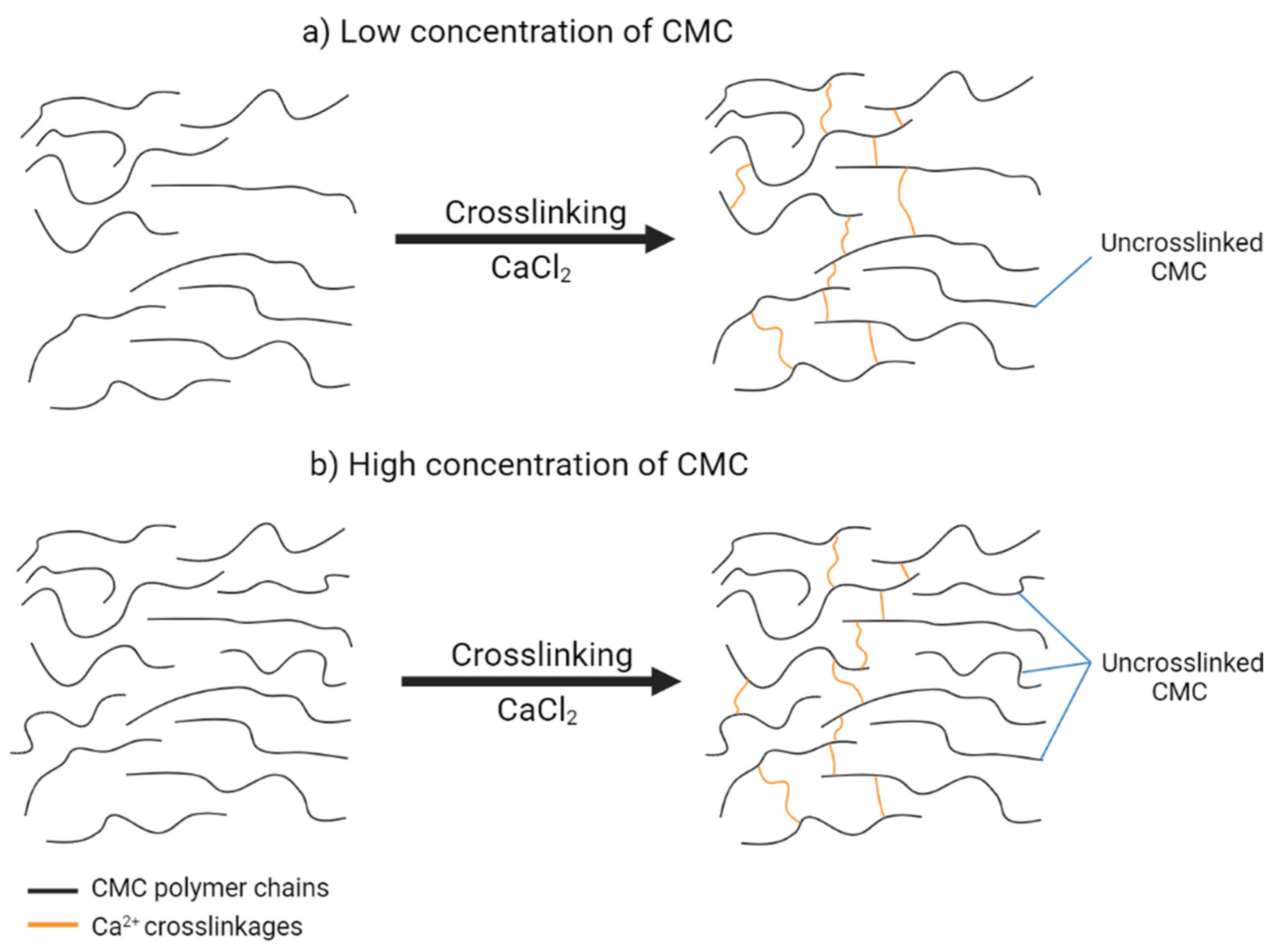

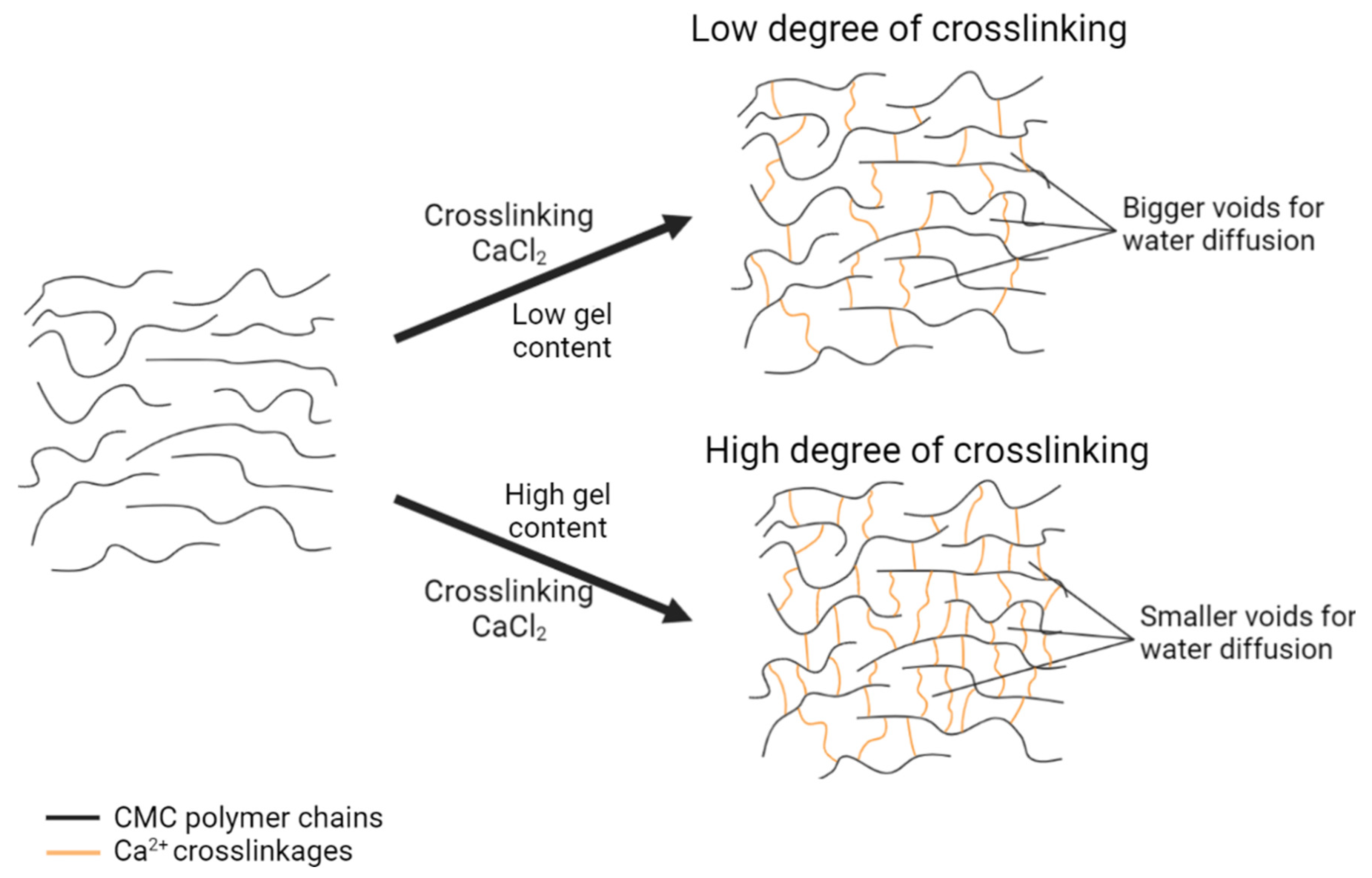
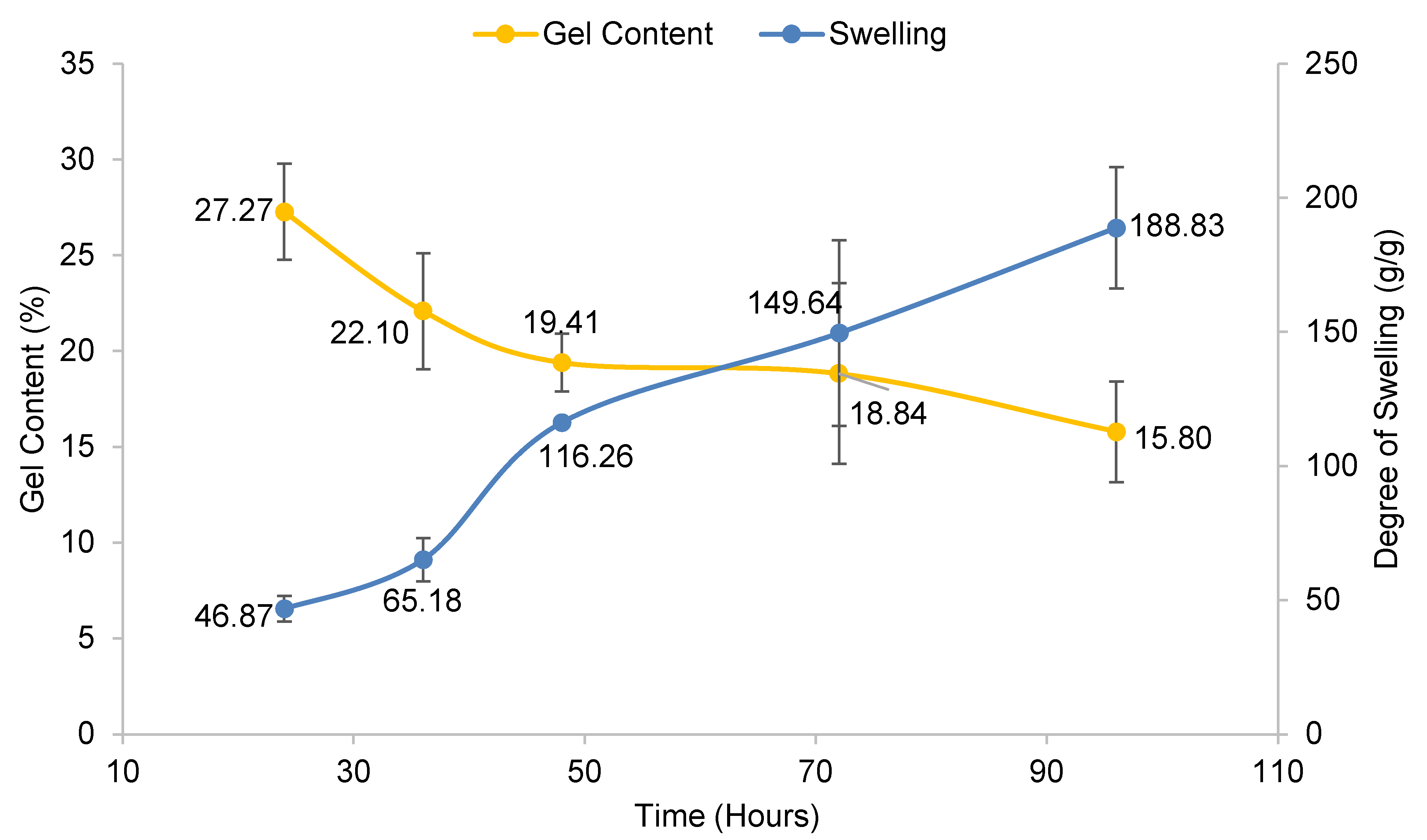
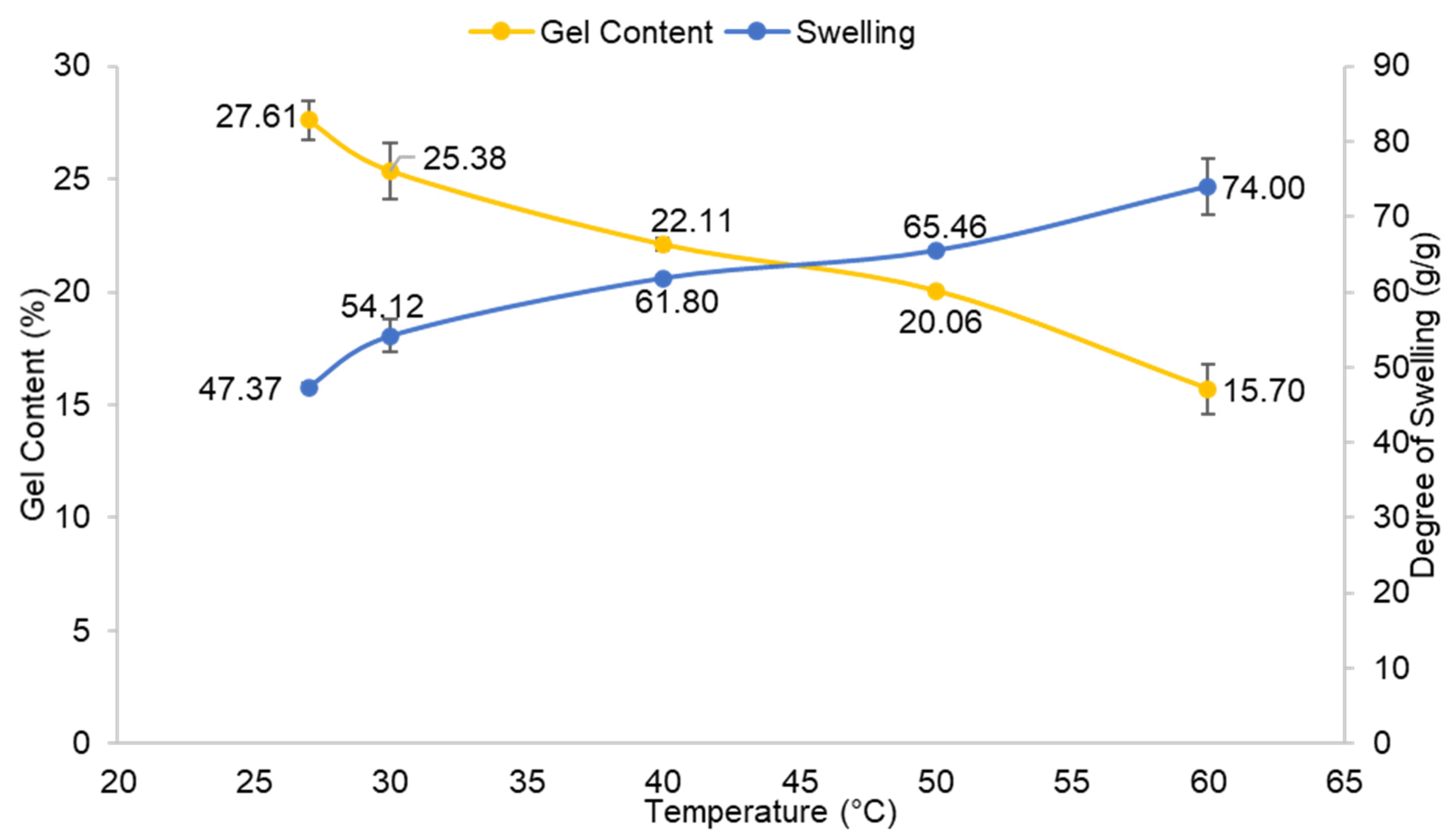
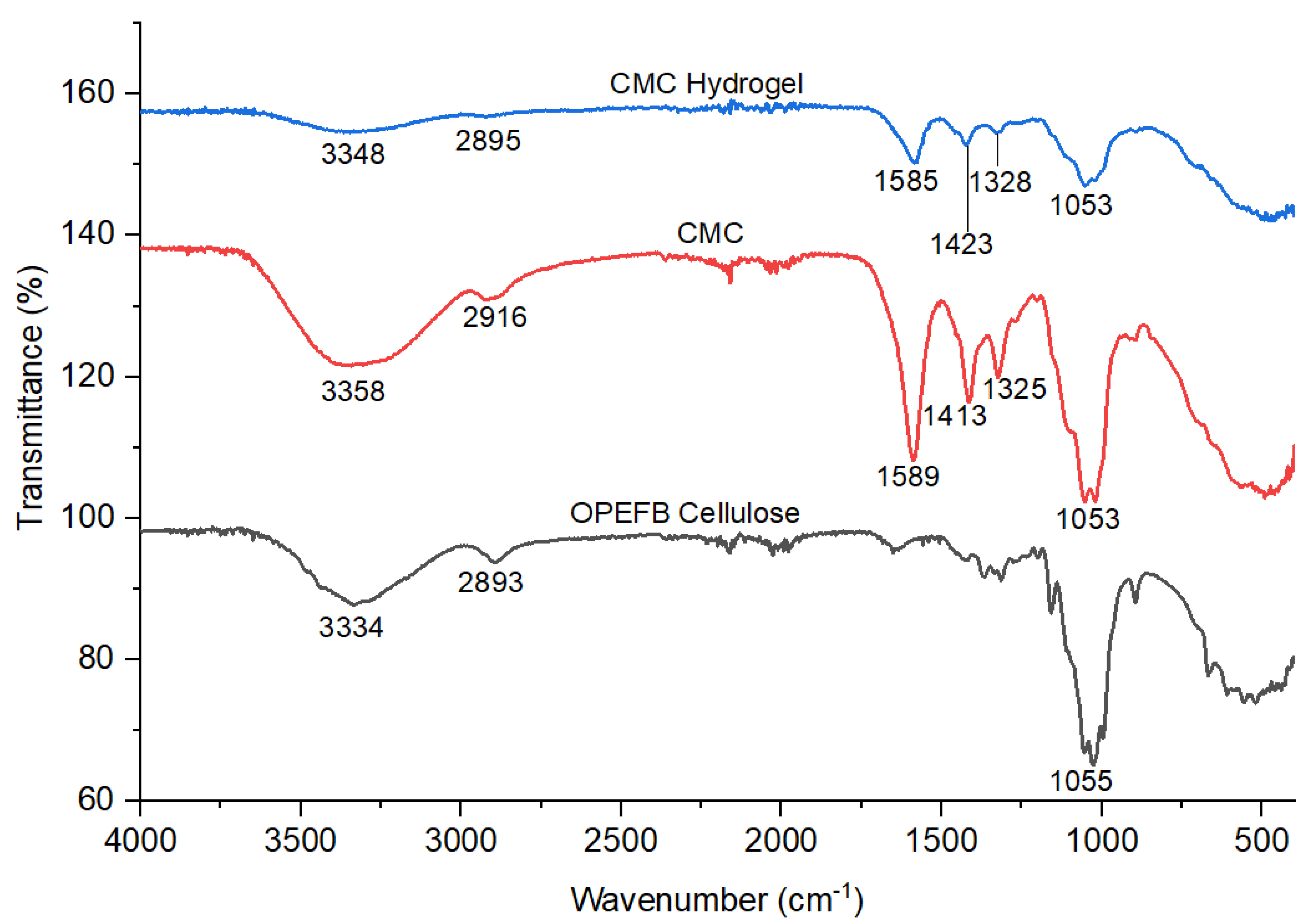

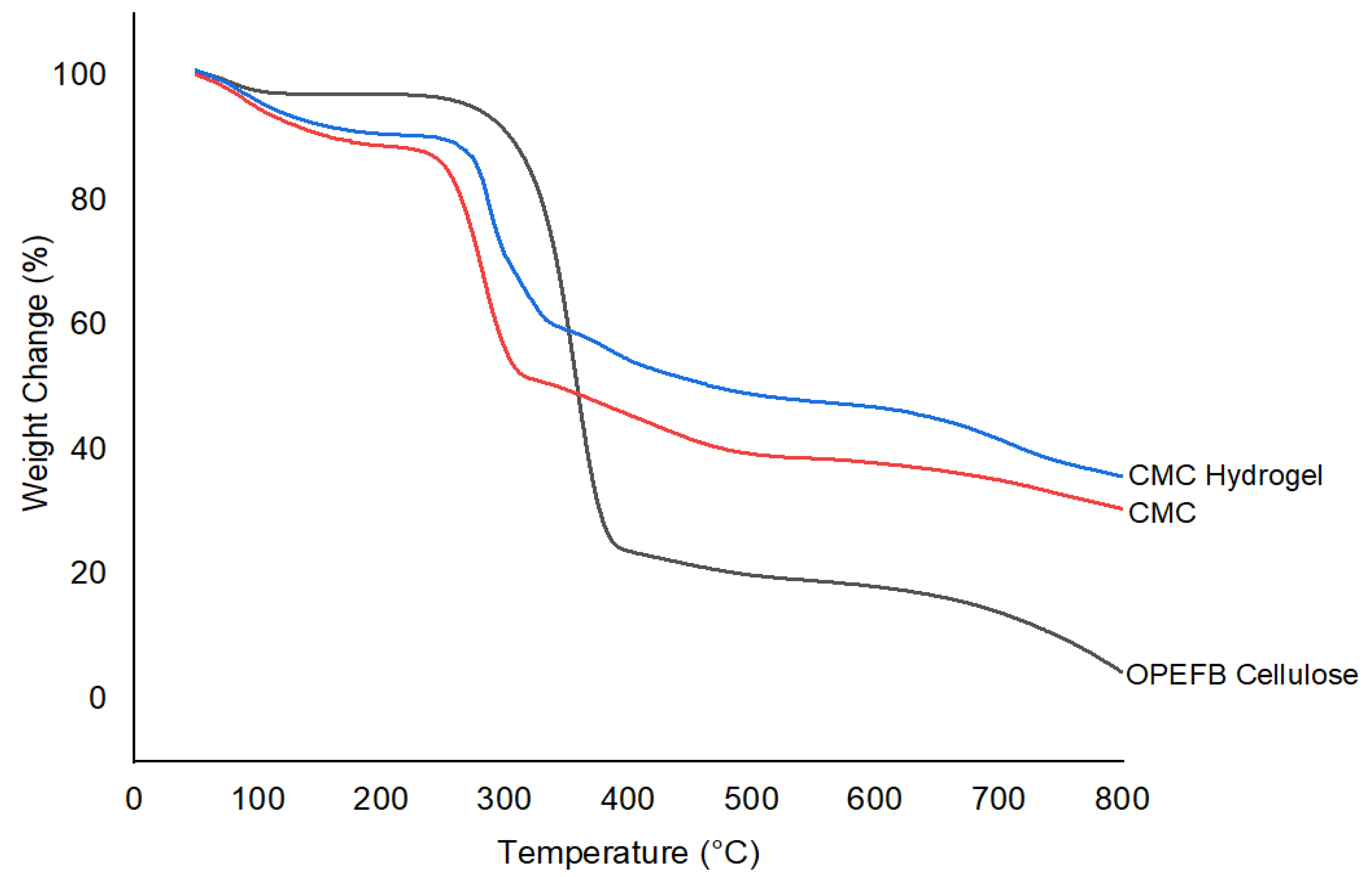
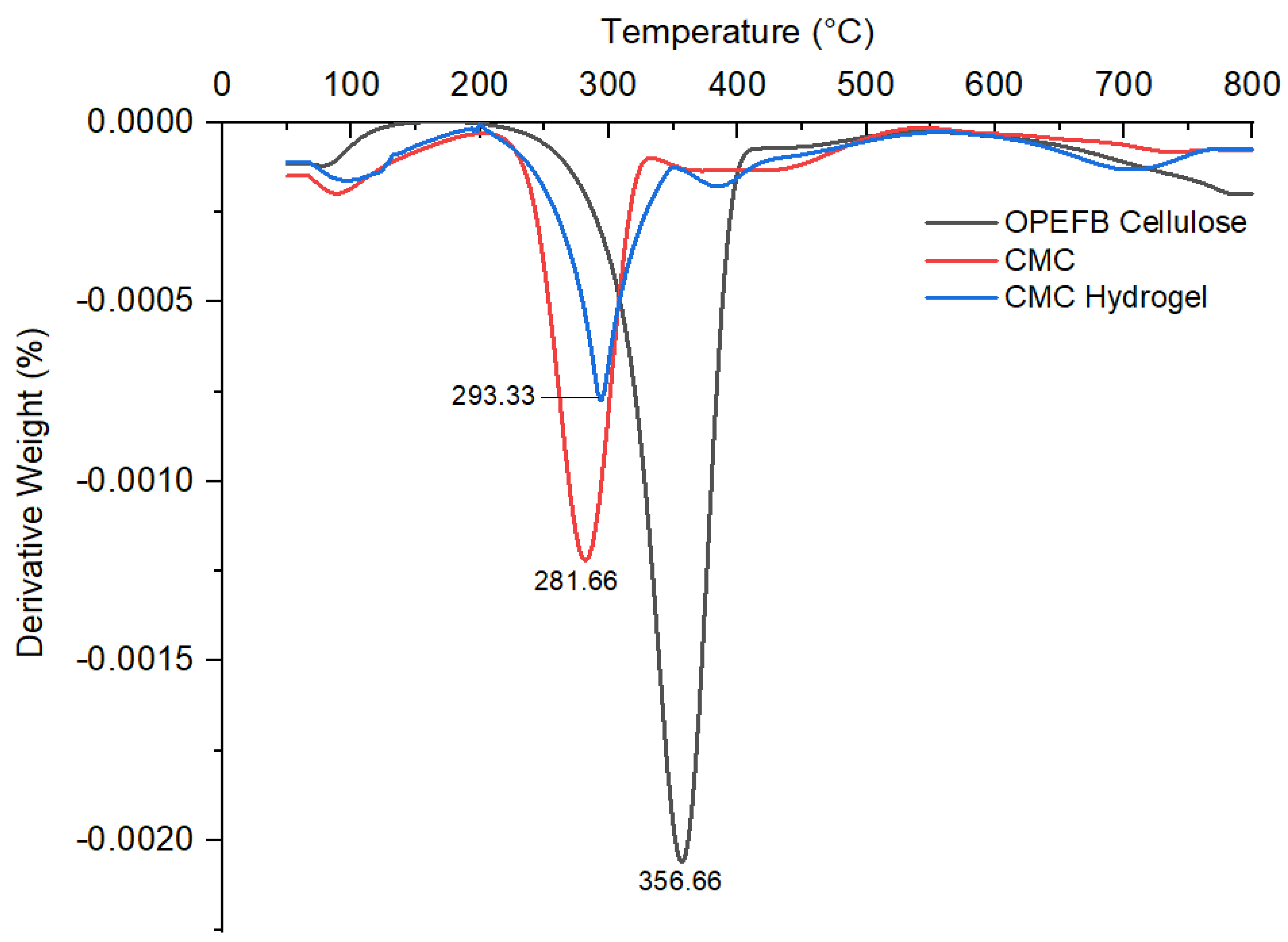
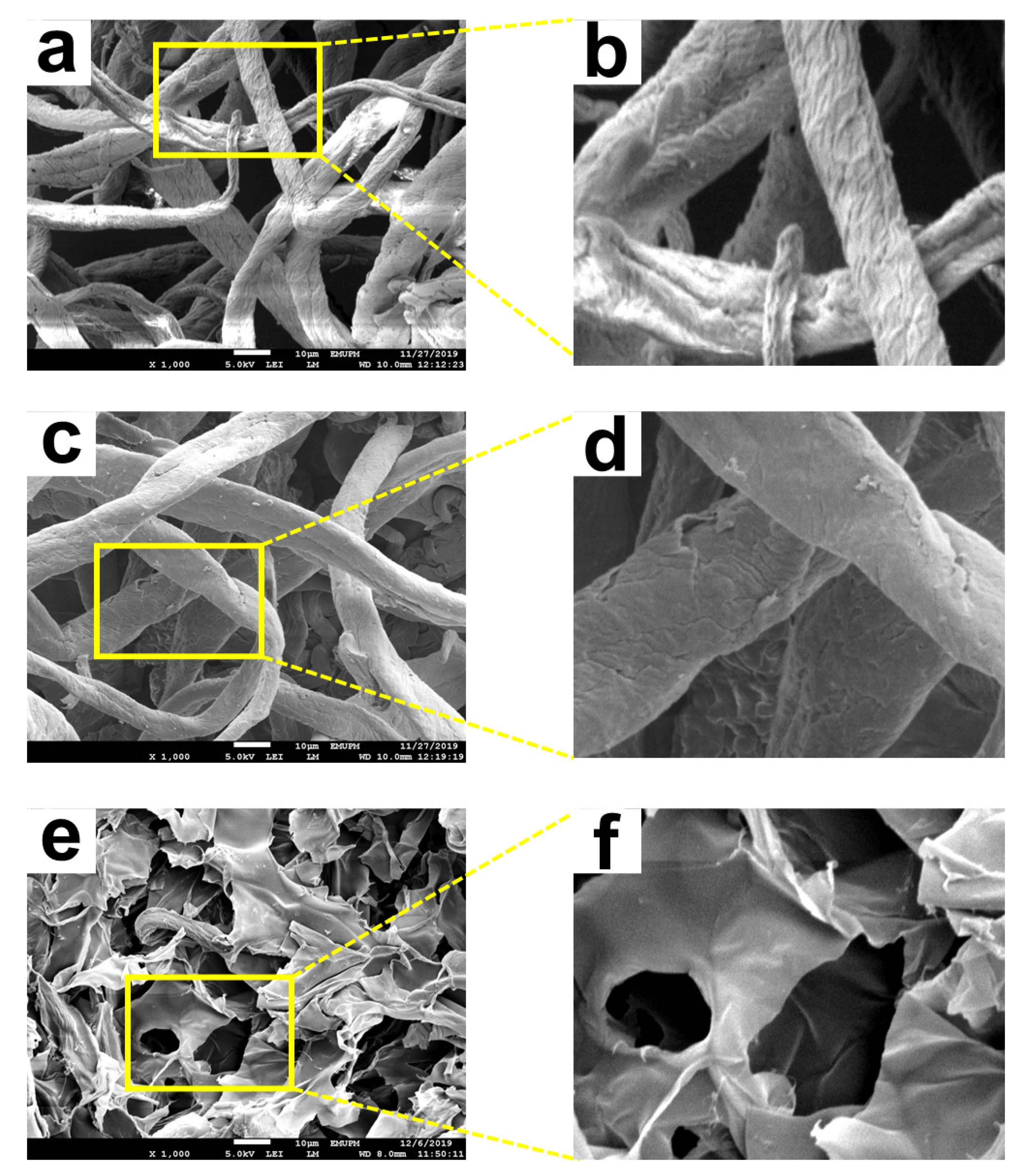
| Sample | Crystallinity Index (%) |
|---|---|
| OPEFB cellulose | 48.70 |
| CMC | 32.77 |
| CMC hydrogel | 4.24 |
Publisher’s Note: MDPI stays neutral with regard to jurisdictional claims in published maps and institutional affiliations. |
© 2021 by the authors. Licensee MDPI, Basel, Switzerland. This article is an open access article distributed under the terms and conditions of the Creative Commons Attribution (CC BY) license (https://creativecommons.org/licenses/by/4.0/).
Share and Cite
Tuan Mohamood, N.F.A.-Z.; Abdul Halim, A.H.; Zainuddin, N. Carboxymethyl Cellulose Hydrogel from Biomass Waste of Oil Palm Empty Fruit Bunch Using Calcium Chloride as Crosslinking Agent. Polymers 2021, 13, 4056. https://doi.org/10.3390/polym13234056
Tuan Mohamood NFA-Z, Abdul Halim AH, Zainuddin N. Carboxymethyl Cellulose Hydrogel from Biomass Waste of Oil Palm Empty Fruit Bunch Using Calcium Chloride as Crosslinking Agent. Polymers. 2021; 13(23):4056. https://doi.org/10.3390/polym13234056
Chicago/Turabian StyleTuan Mohamood, Nur Fattima’ Al-Zahara’, Abdul Hakam Abdul Halim, and Norhazlin Zainuddin. 2021. "Carboxymethyl Cellulose Hydrogel from Biomass Waste of Oil Palm Empty Fruit Bunch Using Calcium Chloride as Crosslinking Agent" Polymers 13, no. 23: 4056. https://doi.org/10.3390/polym13234056
APA StyleTuan Mohamood, N. F. A.-Z., Abdul Halim, A. H., & Zainuddin, N. (2021). Carboxymethyl Cellulose Hydrogel from Biomass Waste of Oil Palm Empty Fruit Bunch Using Calcium Chloride as Crosslinking Agent. Polymers, 13(23), 4056. https://doi.org/10.3390/polym13234056






